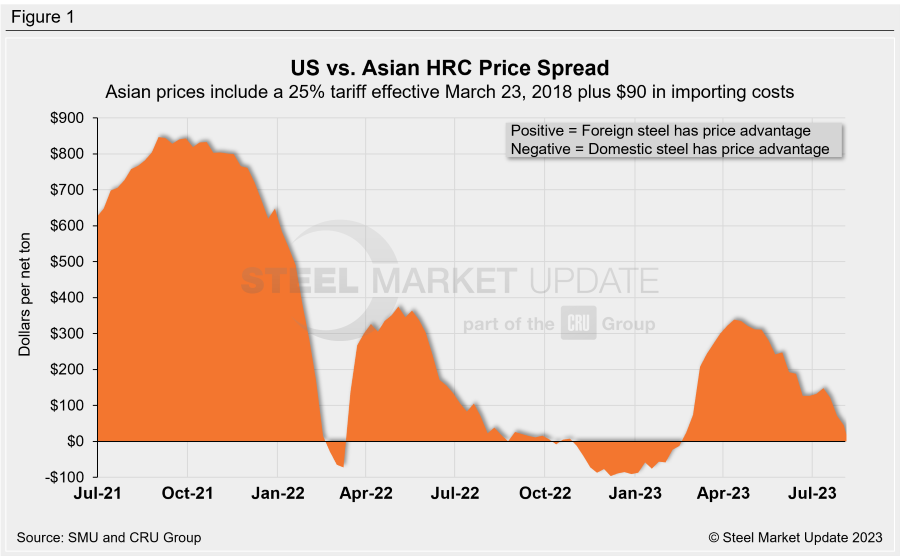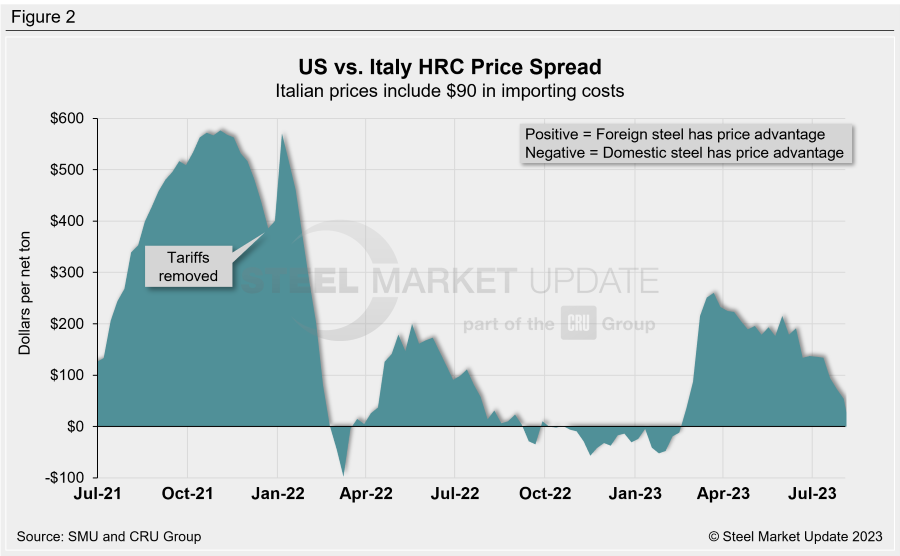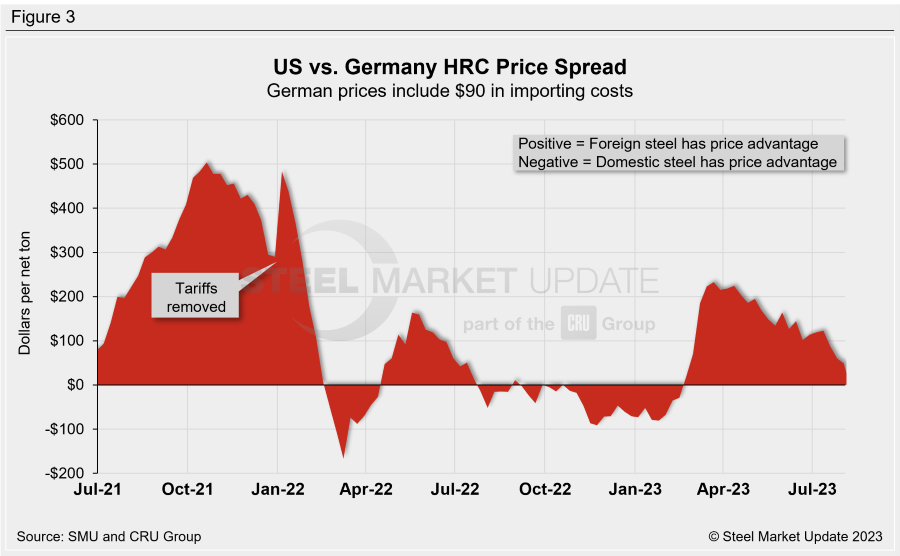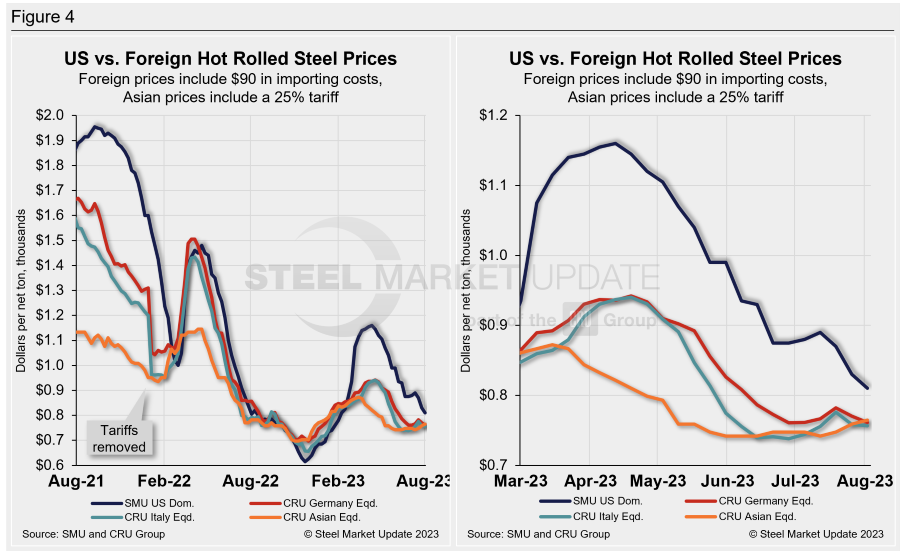Overseas

August 3, 2023
HRC Imports Losing Edge Over US Prices
Written by David Schollaert
The spread between US and offshore hot-rolled coil (HRC) prices has narrowed to its lowest level since mid-February, when domestic prices were still trending upwards, according to SMU’s latest foreign vs. domestic price analysis.
HRC tags stateside, at an average of $810 per net ton, declined by $20 this week from last, slipping to their lowest level since February. Domestic prices are now down $350 per ton since peaking this year at $1,160 per ton back in April and are also down $70 per ton from a month ago.
Prices overseas have seen some weakening, but have overall been largely stable for a few weeks, causing the spread between import and domestic pricing to tighten.
During the downward cycle at the end of 2022, domestic HRC held a price advantage over imported material for about four months. Repeated price hikes by mills to kick off 2023 ballooned the US premium over offshore hot band by more than $260 per ton.
Domestic hot band is now roughly just 6% more expensive than foreign material, down from 8.2% a week ago, and 15% a month ago. While it seems clear for the time being that domestic mills were not successful in their latest efforts to increase prices, margins between domestic and offshore hot band are likely to fluctuate due in part to the seasonally slower summer months.
SMU uses the following calculation to identify the theoretical spread between foreign HRC prices (delivered to US ports) and domestic HRC prices (FOB domestic mills): Our analysis compares the SMU US HRC weekly index to the CRU HRC weekly indices for Germany, Italy, and east and southeast Asia ports. This is only a theoretical calculation because costs to import can vary greatly, influencing the true market spread.
In consideration of freight costs, handling, and trader margin, we add $90 per ton to all foreign prices to provide an approximate CIF US ports price to compare to the SMU domestic HRC price. Buyers should use our $90-per-ton figure as a benchmark and adjust up or down based on their own shipping and handling costs. If you import steel and want to share your thoughts on these costs, we welcome your insight at david@steelmarketupdate.com.
Asian Hot-Rolled Coil (East and Southeast Asian Ports)
As of Thursday, Aug. 3, the CRU Asian HRC price was $540 per ton, up $5 per ton from the previous week, and up $14 per ton from levels one month ago. Adding a 25% tariff and $90 per ton in estimated import costs, the delivered price of Asian HRC to the US is approximately $765 per ton. The latest SMU hot rolled average is $810 per ton.
US-produced HRC is now theoretically $45 per ton more expensive than steel imported from Asia. That figure is down $26 per ton week-on-week (WoW).

Italian Hot-Rolled Coil
Italian HRC prices moved down marginally WoW, declining by $2 per ton to $666 per ton this week. That price is up $12 per ton from a month ago. After adding import costs, the delivered price of Italian HRC is approximately $756 per ton.
Domestic HRC is now theoretically $54 per ton more expensive than imported Italian HRC. That spread is down $18 per ton WoW and is just $66 per ton higher compared to just four months ago when US HRC was $12 per ton cheaper than Italian hot band.

German Hot-Rolled Coil
CRU’s latest German HRC price decreased by $9 per ton WoW to $671 per ton and is unchanged from a month ago. After adding import costs, the delivered price of German HRC is roughly $761 per ton.
Domestic HRC is now theoretically $49 per ton more expensive than imported German HRC. That’s down $11 per ton WoW, and down $21 per ton vs. one month ago.

Figure 4 compares all four price indices. The chart on the right zooms in to highlight this year’s decoupling of US and offshore HRC prices.

Notes: Freight is an important consideration in deciding whether to import foreign steel or buy from a domestic mill. Domestic prices are referenced as FOB the producing mill, while foreign prices are CIF the port (Houston, NOLA, Savannah, Los Angeles, Camden, etc.). Inland freight, from either a domestic mill or from the port, can dramatically impact the competitiveness of both domestic and foreign steel. It’s also important to factor in lead times. In most markets, domestic steel will deliver more quickly than foreign steel.
Effective Jan. 1, 2022, the traditional Section 232 tariff no longer applies to most imports from the European Union. It has been replaced by a tariff rate quota (TRQ). Therefore, the German and Italian price comparisons in this analysis no longer include a 25% tariff. SMU still includes the 25% Section 232 tariff on foreign prices from other countries. We do not include any antidumping (AD) or countervailing duties (CVD) in this analysis.







